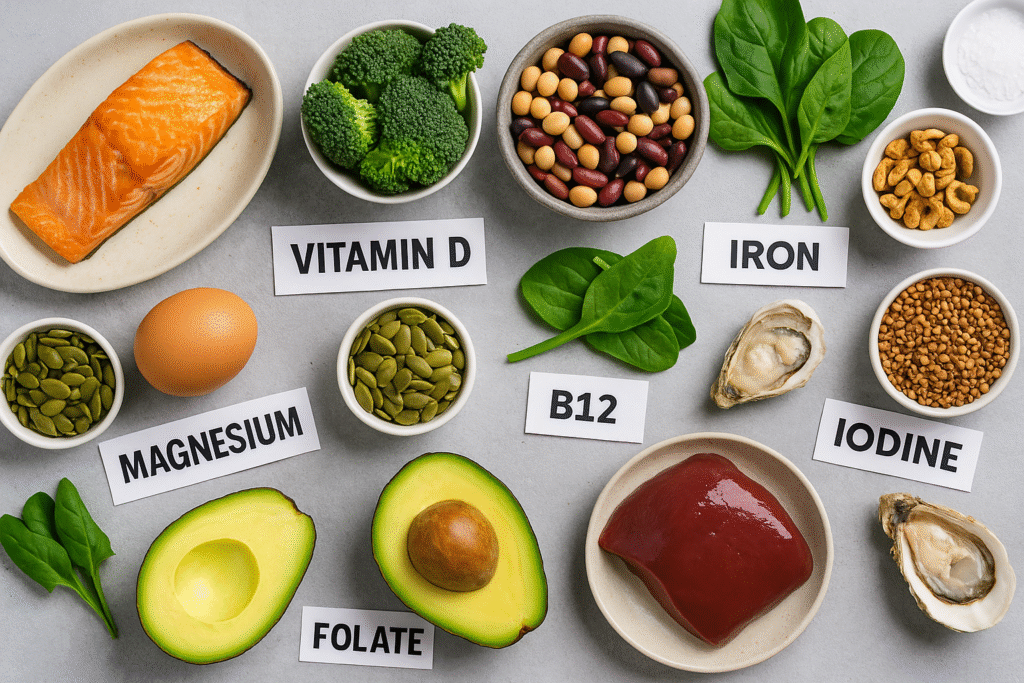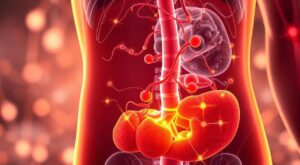In today’s health-conscious world, we hear plenty about carbs, protein, and fat—but what about micronutrients? These tiny nutritional powerhouses don’t get nearly the spotlight they deserve, yet they play a vital role in everything from immune defense to energy production and mental clarity.
Surprisingly, even people who eat a “balanced” diet often fall short of key vitamins and minerals. A CDC report revealed that nearly 10% of Americans are deficient in at least one essential nutrient, and that’s just the tip of the iceberg.
In this ultimate guide, we’ll dive deep into the world of micronutrients, explore their functions, uncover hidden deficiencies, and show you how to optimize your diet for better health, more energy, and a stronger immune system. If you’ve ever felt tired, foggy, or just not your best—you might be missing more than you think.
What Are Micronutrients and Why Do They Matter?
Micronutrients are the vitamins and minerals your body needs in small amounts—but don’t let the word “micro” fool you. Despite their size, they have a macro impact on your health. From enabling cellular processes to protecting against chronic disease, micronutrients are the invisible architects of well-being.
The Two Categories of Micronutrients
Micronutrients fall into two main categories:
1. Vitamins
These are organic compounds vital for various metabolic processes. They’re classified as:
- Fat-soluble (A, D, E, K): Stored in the body’s fat tissues and liver. These are absorbed along with dietary fat and released slowly.
- Water-soluble (B-complex, C): Not stored in the body. Excess is excreted via urine, requiring daily replenishment.
2. Minerals
Inorganic elements that serve structural and regulatory functions. Key examples include:
- Macrominerals (e.g., calcium, magnesium, potassium)
- Trace minerals (e.g., zinc, selenium, iron)
💡 Quick Tip
To boost micronutrient absorption, combine fat-soluble vitamins with healthy fats like olive oil or avocado. For iron, pair with vitamin C-rich foods.
What Do Micronutrients Do in the Body?
Every single system in your body relies on micronutrients to function properly:
- Immune system: Zinc and vitamin C help regulate white blood cell production.
- Nervous system: B-vitamins support neurotransmitter synthesis and nerve repair.
- Bone health: Vitamin D, calcium, and magnesium form the trifecta for skeletal strength.
- Energy metabolism: Iron carries oxygen in blood; B12 helps convert food into ATP.
📌 Did You Know?
Even a mild deficiency in magnesium can lead to muscle cramps, insomnia, and increased anxiety. It’s one of the most underdiagnosed imbalances in adults.
Signs You Might Be Missing Micronutrients
Many deficiencies fly under the radar until they cause chronic issues. Here are common warning signs:
- Fatigue or brain fog → May indicate iron, B12, or magnesium deficiency
- Dry skin or brittle nails → Could signal lack of zinc or biotin
- Frequent infections → Low levels of vitamins C, D, or zinc
- Mood swings or depression → Possible B6, B12, or folate imbalance
✅ Expert Summary
Micronutrients, though needed in small amounts, have a profound effect on physical and mental health. A deficiency in just one can throw off the body’s delicate balance, underscoring the importance of a nutrient-dense diet.
The Most Common Micronutrient Deficiencies in the U.S.
Despite access to an abundance of food, the typical American diet—rich in processed ingredients and low in nutrient density—leaves many people unknowingly deficient in key micronutrients. According to data from the CDC and National Health and Nutrition Examination Survey (NHANES), several nutrients are chronically under-consumed.

The Top Deficiencies Affecting Americans
1. Vitamin D
- Estimated Deficiency Rate: 42% of U.S. adults
- Why it Matters: Vitamin D regulates calcium absorption, supports immune function, and reduces inflammation.
- Symptoms of Deficiency: Fatigue, joint pain, bone loss, increased susceptibility to infections
- Sources: Sunlight, fatty fish (salmon, mackerel), fortified dairy
2. Magnesium
- Estimated Deficiency Rate: 50% of adults get less than the recommended daily intake
- Why it Matters: Supports over 300 enzymatic reactions, including muscle and nerve function, blood glucose control, and blood pressure regulation.
- Symptoms: Muscle cramps, anxiety, poor sleep, irregular heartbeat
- Sources: Leafy greens, nuts, seeds, whole grains
3. Vitamin B12
- High-risk groups: Vegans, vegetarians, older adults
- Why it Matters: Essential for red blood cell formation, neurological function, and DNA synthesis.
- Symptoms: Fatigue, numbness, memory issues, mood swings
- Sources: Animal products (meat, eggs, dairy), fortified plant milks
4. Iron
- Particularly at risk: Women of reproductive age, children, and vegetarians
- Why it Matters: Vital for oxygen transport and energy metabolism.
- Symptoms: Pale skin, shortness of breath, cold extremities, fatigue
- Sources: Red meat, lentils, spinach, iron-fortified cereals
5. Calcium
- Why it Matters: Supports bone strength, nerve transmission, and muscle function.
- Symptoms of Deficiency: Osteopenia, brittle nails, muscle spasms
- Sources: Dairy, tofu, broccoli, fortified plant-based milk
What the Research Says
🧠 What the Research Says
A review published in the Journal of Nutrition found that up to 94% of Americans do not meet the estimated average requirement (EAR) for vitamin D, calcium, and magnesium when diet alone is considered.
The Link Between Deficiency and Chronic Disease
Multiple studies show correlations between long-term micronutrient deficiencies and higher risks for conditions such as:
- Heart disease (low magnesium and potassium)
- Type 2 diabetes (low vitamin D and chromium)
- Cognitive decline (low B12, folate, omega-3s)
- Osteoporosis (calcium and vitamin D deficiency)
Key Micronutrients and U.S. Deficiency Data
| Micronutrient | Deficiency Rate (%) | Key Functions | Best Sources |
|---|---|---|---|
| Vitamin D | 42% | Bone health, immune regulation | Sunlight, salmon, fortified milk |
| Magnesium | ~50% | Muscle and nerve function, glucose control | Leafy greens, nuts, whole grains |
| Vitamin B12 | ~15% (higher in elderly) | Nerve health, red blood cell production | Meat, dairy, fortified cereals |
| Iron | ~10% (higher in women) | Oxygen transport, energy | Red meat, spinach, lentils |
| Calcium | 30–40% | Bone strength, muscle function | Dairy, tofu, fortified milk |
How to Improve Micronutrient Intake Naturally
Correcting micronutrient deficiencies doesn’t require a cabinet full of supplements—although strategic supplementation can help. In many cases, adjusting your diet and lifestyle is the most effective and sustainable solution. Here’s how to do it with precision.
Eat a Diverse, Whole-Foods-Based Diet
The foundation of micronutrient sufficiency is variety. Processed foods tend to be calorie-dense but nutrient-poor. In contrast, whole foods—especially vegetables, fruits, legumes, nuts, seeds, and quality proteins—offer dense micronutrient profiles.
Key Strategies:
- Color diversity: Different colored produce often indicates a different nutrient profile. For example, orange vegetables are rich in beta-carotene (vitamin A), while dark leafy greens provide magnesium, calcium, and folate.
- Rotate your greens: Don’t rely solely on spinach. Try kale, chard, collards, and arugula to get a broader nutrient spread.
- Fermented foods: Sauerkraut, kimchi, and kefir not only support gut health but also enhance vitamin B absorption.
Optimize Food Pairings
Bioavailability—the body’s ability to absorb and use nutrients—is just as important as intake quantity.
Examples of Synergistic Pairings:
- Vitamin D + Calcium: Enhances bone absorption
- Iron + Vitamin C: Boosts non-heme iron uptake from plant foods
- Fat-soluble vitamins (A, D, E, K) + Healthy fats: Required for optimal absorption
💡 Quick Tip
Add avocado or olive oil to your salad to enhance absorption of fat-soluble vitamins and antioxidants like lutein and beta-carotene.
Practice Mindful Cooking and Storage
Certain cooking methods preserve or even enhance nutrient content, while others destroy them.
Best Practices:
- Steam over boil: Steaming retains more water-soluble vitamins like B and C.
- Avoid high heat for oils: Excessive heat can degrade fat-soluble nutrients.
- Store in cool, dark places: Light and heat degrade vitamins A and E.
📌 Did You Know?
Micronutrients like vitamin C can degrade by up to 50% in cooked vegetables left in the fridge for more than 48 hours. Freshness matters.
Supplement Strategically (When Necessary)
While food should be your primary source, supplements can help bridge specific gaps—especially for at-risk populations:
- Vitamin D: Often needed during winter or for those with limited sun exposure
- B12: Essential for vegans and vegetarians
- Iron: For menstruating women, especially if dietary intake is low
- Magnesium: Helpful for those with stress, insomnia, or high caffeine intake
✅ Expert Summary
The best way to ensure optimal micronutrient levels is through a diverse, unprocessed, and strategically combined diet. Supplements can serve as a useful backup, but they should never replace nutrient-rich foods as the primary source.
Micronutrient Needs by Life Stage and Lifestyle
Micronutrient requirements aren’t one-size-fits-all. Age, gender, activity level, health status, and lifestyle choices all play significant roles in determining how much of each vitamin and mineral your body needs. Here’s a detailed look at the shifting nutritional landscape throughout life—and how to navigate it effectively.

Infants and Children: Laying the Foundation
During growth, micronutrients support tissue development, brain maturation, and immune function.
Priority Nutrients:
- Iron: Critical for cognitive development; deficiency can impair learning and attention.
- Vitamin A: Supports vision and immune defense.
- Zinc: Important for cellular growth and repair.
- Vitamin D + Calcium: Essential for skeletal development.
Pediatricians often recommend a vitamin D supplement for breastfed infants, as breast milk may not supply adequate amounts.
Women of Reproductive Age: Balancing Cycles and Fertility
Hormonal fluctuations, menstruation, pregnancy, and lactation increase the demand for several micronutrients.
Key Micronutrients:
- Iron: Lost through menstruation; deficiency is common and leads to fatigue, anemia, and reduced immunity.
- Folate (B9): Essential for neural tube development in early pregnancy; best sourced from leafy greens and legumes.
- Calcium and Vitamin D: Crucial for bone health, especially during pregnancy and postpartum.
- Iodine: Needed for fetal brain development.
📌 Did You Know?
Up to 22% of U.S. women aged 18–45 are estimated to have suboptimal iodine levels, according to NHANES data. This may impair thyroid and fetal brain function.
Adults and Active Individuals: Fueling Performance and Resilience
For physically active adults, micronutrients play a vital role in recovery, energy metabolism, and injury prevention.
Must-Have Nutrients:
- Magnesium: Depleted by sweat and stress; supports muscle function and energy.
- B-complex vitamins: Crucial for ATP production and oxygen transport during exercise.
- Antioxidants (vitamin C, E, selenium): Combat exercise-induced oxidative stress.
- Electrolytes (potassium, sodium, chloride): Regulate fluid balance and muscle contractions.
💡 Quick Tip
If you’re training intensely or sweating heavily, add mineral-rich foods like bananas, spinach, and coconut water to your post-workout meal to restore micronutrient balance.
Older Adults: Preventing Decline and Supporting Longevity
Aging changes nutrient absorption and increases the risk of deficiencies—even with adequate intake.
Nutrients of Concern:
- Vitamin B12: Absorption declines with age due to reduced stomach acid; deficiency can mimic dementia.
- Vitamin D: Skin synthesis decreases over time; supplementation is often necessary.
- Calcium and Magnesium: Essential to preserve bone density and prevent fractures.
- Zinc and Selenium: Support immune surveillance and reduce inflammation.
✅ Expert Summary
Life stage and lifestyle dramatically influence your body’s micronutrient needs. Customizing intake based on these factors—rather than relying on generic recommendations—can prevent deficiencies, support optimal performance, and slow aging-related decline.
Testing, Tracking, and Personalizing Your Micronutrient Strategy
Even the most mindful eaters can fall short on micronutrients without realizing it. That’s why a personalized strategy—rooted in data, not guesswork—is key to achieving true nutritional balance. Here’s how to take control of your micronutrient status through evidence-based tools and smart monitoring.

Step 1: Test Before You Supplement
Relying solely on symptoms can be misleading. Fatigue could stem from iron, magnesium, or even B12 deficiency—but also from lifestyle or sleep. That’s where lab testing comes in.
Most Reliable Tests:
- Serum blood panels: Measure circulating levels of nutrients like vitamin D, B12, and iron.
- RBC (red blood cell) magnesium test: More accurate than serum magnesium, as it reflects intracellular status.
- Homocysteine and methylmalonic acid: Functional indicators of B12 and folate adequacy.
- Ferritin: The best marker for stored iron levels.
Functional medicine and integrative health clinics often offer comprehensive micronutrient panels through labs like SpectraCell, Genova, or Vibrant America.
Step 2: Interpret the Results with Context
A nutrient being “within range” doesn’t always mean it’s optimal. Reference ranges are broad and based on avoiding disease, not maximizing function.
Example:
- Vitamin D “normal” range: 20–100 ng/mL
- Optimal for immune and bone health: 40–60 ng/mL (per Endocrine Society guidelines)
📌 Did You Know?
A 2023 study published in the *Journal of Clinical Endocrinology* found that people with vitamin D levels between 40–60 ng/mL had 35% fewer respiratory infections than those with levels below 30.
Step 3: Tailor Your Nutrition Accordingly
Once you’ve identified your gaps, it’s time to personalize your strategy:
Custom Approaches by Deficiency:
- Low Iron: Add vitamin C-rich foods to iron-rich meals, avoid tea or coffee near mealtime
- Low B12: Emphasize animal products or take a methylcobalamin supplement (especially for vegans)
- Low Magnesium: Increase intake of pumpkin seeds, avocado, and Epsom salt baths for transdermal absorption
- Low Vitamin D: Combine sunlight exposure with high-quality D3 supplementation and dietary fats
✅ Expert Summary
Micronutrient optimization starts with lab testing, not assumptions. From there, you can fine-tune your diet and supplement plan to your body’s unique needs—enhancing energy, immunity, and long-term vitality.
🧠 What the Research Says
A randomized clinical trial published in Nutrients (2021) showed that personalized micronutrient supplementation, based on blood test analysis, improved metabolic and inflammatory markers more effectively than a standard multivitamin.
Conclusion
Micronutrients may be “micro” in name, but their impact on your health is anything but small. From energy levels and mood to bone strength and immunity, these essential nutrients power nearly every function in your body. Unfortunately, modern diets and lifestyles often create gaps that go unnoticed—until symptoms appear.
The good news? You can reclaim control. By eating a varied, whole-food-based diet, paying attention to synergistic food pairings, testing your levels, and customizing your intake, you can optimize your micronutrient status for better performance, resilience, and long-term wellness.
Micronutrient awareness is no longer optional—it’s essential.
📌 Main Takeaways
- Micronutrients are vital nutrients needed in small amounts to support metabolism, immunity, cognition, and more.
- Common deficiencies in the U.S. include vitamin D, magnesium, iron, and B12—even among people with healthy diets.
- Whole foods, bioavailable pairings, and strategic cooking dramatically improve nutrient intake and absorption.
- Different life stages and lifestyles require customized micronutrient strategies, from infancy to older adulthood.
- Personalized testing and interpretation provide the most accurate roadmap to correct imbalances and optimize health.
🔗 Further Reading
Want to go deeper?
Discover how each nutrient powers your system from head to toe: The Complete Guide to Essential Nutrients for Your Body
Fuel your results with food that works
Get our expert-designed protein meal plan to lose weight while nourishing your body: High-Protein Meal Plan for Weight Loss
Is your liver slowing your metabolism?
Find out how HepatoBurn supports fat loss through better liver function and nutrient detox: Discover HepatoBurn – The Metabolism Support Formula














